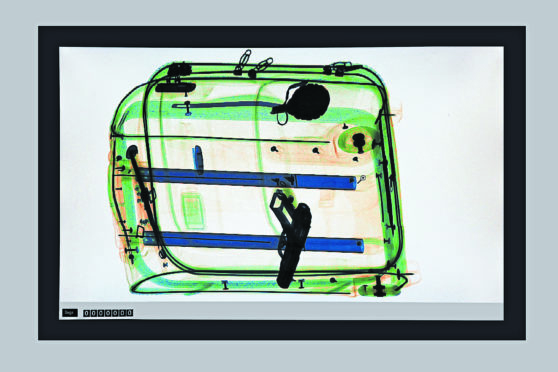Workers standing in for striking scanner staff missed more than 260 potential threats in two days at Scots airports, it has emerged.
Staff who operate baggage X-ray scanners at Glasgow and Aberdeen airports have been among those taking part in industrial action this month.
Managers have drafted in contingency workers from other airports to fill in for strikers but replacement workers at both airports have failed to spot large numbers of suspicious items on baggage scanners.
A source at Glasgow revealed around 95 suspicious items had slipped through on each of the first two strike days. Aberdeen, meanwhile, saw around 70 missed items over the two days.
Unions have questioned the competence of stand-in staff and claim more is being spent bringing in replacements than it would cost to end the dispute.
More walkouts are planned in Scotland tomorrow and on Wednesday.
Similar action is taking place at Southampton airport as part of a dispute over final salary pensions between unions and AGS Airports which operates the three transport hubs.
To ensure vigilance, the airport’s security system beams images of prohibited items into randomly chosen bags as they are scanned.
It’s understood around 100 of the threat images – which can include bomb components, guns or knives – were missed during the first eight-hour strike shift at Glasgow on June 7. The normal number for that period is around 10.
One operator alone missed more than 20 items. Failing to notice three threats normally results in disciplinary action.
A Glasgow Airport insider said: “When operators see something suspicious on their screen they have no way of knowing if the item is real or if it’s a projected image.
“Every item missed is a potentially lethal threat to an aircraft. It is an effective tool to keep people alert and properly checking every bag as it goes through.”
And an Aberdeen airport source said: “There are major concerns about what is going on. You wonder what else they are missing?”
Aviation security analyst Tim Ripley said: “Any reduction such as this in the efficiency of people monitoring luggage for security purposes is a major concern.
“It is a skilful job to spot dangerous items.
“There are strict regimes with breaks, rest periods and swapping staff over, as they have to be sharp at all times. There is a well-known saying that terrorists only have to be lucky once. Security personnel have to be focused at all times.”
Glasgow Airport and Aberdeen airports said the contingency workers are “trained and certified to the same UK standards” as those they are standing in for.
It’s also claimed the Civil Aviation Authority – which oversees UK airport security – has not performed checks on strike days.
CAA could shut down an airport if they believe security is being compromised. Sources also claim security operatives who walk through with prohibited items to ensure they would be detected have not been performing these checks on strike days.
The industrial action involves security and fire safety officers, airfield operations staff and engineering technicians.
It has resulted in long delays at airport security and a suspension of some flights.
A CAA spokesman said: “For security reasons we cannot discuss when we carry out inspections.
“Each UK airport is responsible for meeting the security requirements set out in UK and international law.
“CAA inspectors ensure that the aviation industry as a whole meets these security requirements and, where issues arise, they are rectified swiftly.”
